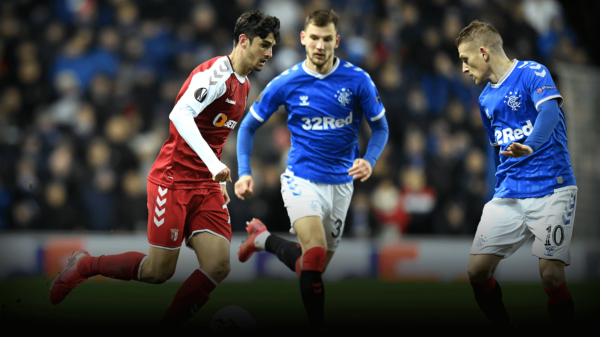Daniel Wong provides an in-depth tactical analysis about the Euro 2016 semi final that ended Portugal 2-0 Wales.
On the day, Chris Coleman elected to start his Welsh side in a 5-3-1-1 in order to try and deal with Portugal’s attacking prowess. However, they were undone by several moments of lost concentration as their fairy tale came to an abrupt end. Goals from Ronaldo and Nani confirmed their exit from Euro 2016. Wales’ shape, lack of movement, and presence in the Portuguese penalty box will be explored in this tactical analysis as I try to explain why the Welsh were so ineffective.
Line-ups

Made using Tactical Pad
Portugal(4-4-2 Diamond): Rui Patricio, Guerreiro, Alves, Fonte, Soares; Pereira; Mario, Sanches; Adrien Silva; Ronaldo, Nani
Wales (5-3-1-1): Hennessey; Taylor, Chester, Williams, Collins, Gunter; King, Ledley, Allen; Bale; Robson-Kanu
The Portuguese Setup
Portugal set up in a 4-4-2 diamond, playing a very narrow and disciplined game in defence, while allowing their attacking players to get forward once in possession. In the attack, Portugal’s forwards would either run out wide into space, or drop deeper to combine with their midfielders, who would get forward into the box and attacking positions. This can be consistently seen in each of their chances.
On the other end, Portugal curiously elected not to do what many top teams do in the modern game today: change shape in defence. They remained in a 4-4-2 diamond and maintained their narrow shape despite Wales’ width. Furthermore, Joao Mario and Renato Sanches consistently moved over to their flanks to close down the Welsh wing backs instead of Guerreiro and Soares, which left large gaps of space for the Welsh to exploit.
The Welsh Setup and Lack of Movement or Support
The Welsh side set up in a manner to stem Portuguese attacks, while giving the team width and Gareth Bale space to move into once in possession. However, Wales ended up sitting too deep, giving the Portuguese strikers time to drop deep to receive the ball and shoot or combine with their midfielders who were allowed to make deep runs. Furthermore, because of their shape and their inability to get attacking players forward, the Welsh were limited to a few options in the build-up:
- Send long balls to Robson-Kanu or Andy King
- Recycle possession until channels opened up
- Switch the play to their wing backs
In possession, the Welsh wing backs would move higher up the wings, while the back three would spread out with Allen and Ledley acting as pivots. King and Bale were given free roles in possession, with Bale consistently dropping deep to receive the ball and King getting into the box if Robson-Kanu went into wider areas, or into pockets of space as the ball was passed around.
Unlike the Italians, who had used the 5-3-2 formation during the tournament, the more attacking of the Welsh players were too far away to combine and hold up the ball. Because of Wales’ shape and build-up, Robson-Kanu found himself hopelessly isolated. Furthermore, the towering Fonte and Alves consistently beat him to the ball, causing Robson-Kanu leaving little to no impact in Welsh attacks. The long ball option was an absolute failure, with majority of the long balls played by Wales scooped up by the Portuguese, sending them on the offensive.
To their credit, the Welsh did a great job in recycling possession, and when they weren’t switching the play to their wing backs or sending the ball long, they created gaps of space within the Portuguese midfield, mainly in the channels along the sides of the pitch. When the ball was passed to Taylor and Gunter, they would be closed down by Sanches and Mario respectively, which would leave gaps of space to move into in the middle or acres of space for the wingback on the other side of the pitch. As Taylor and Gunter pushed higher up, the responsibility to close down was left to Soares and Guerreiro. When the ball was on their side, they would drop deeper to feign reception of the ball, dragging their markers with them and creating channels for Bale to move into.
Disappointingly, these spaces in the midfield were not exploited nearly enough, with King and Robson Kanu electing to make forward runs instead of dropping to support the build-up.
As a result, Wales ended up recycling possession without any real threat, leading them to change their shape to 4-3-1-2 and bring on Church and Vokes when they began to chase the game. Unfortunately, Bale found himself doing the lion’s share of the attacking.
Goals and Some Notable Chances
An interesting detail to note in the chances and in the goals is the difference between the amount of players getting into the box. Portugal would have at least 2-3 players in the box almost every time the ball was played into the box, whilst Wales rarely had 2 players in the box until the second half.
16’ Ronaldo drops deep to receive the ball and combines with Joao Mario, as he is immediately closed down by Chester. However, the entire Welsh back line remains very deep, leaving a huge gap for Joao Mario – who shoots wide
19’ Bale fires a shot wide after a nice training ground corner. Portugal defended their corner using mixed marking and the man marked players made the most of this, pushing and holding their markers forward. Pereira leaves Bale alone, as he must remain in his zone due to his instructions. The result leaves the massive space for Bale to get a shot off.
23’ Bale cuts in after carrying the ball from his own half, but fires it straight at Rui Patricio. The key thing to note is the lack of attacking vision and movement from Robson-Kanu, either from a lack of belief that Bale would pass, or a simple lack of off the ball mentality. Robson-Kanu does not appear to sprint into space, nor does he make any sort of movement or run to give Bale the option to pass or to drag one of the defenders with him.
50’ Ronaldo Goal: Ronaldo heads in a thundering header following a training ground corner from the Portuguese. As the corner is played short, Ronaldo makes a run into the centre of the box to pull Chester with him. As the cross is played in, Ronaldo sprints towards Fonte and the far post to smash home the header. Fonte doesn’t even bother to jump, as his role was to block his Chester and his own marker.
53’ Nani Goal: It is important to note that again the Portuguese forwards are either dropping deep (Nani) or going wide (Ronaldo) in the build up. Ronaldo receives the ball wide and recycles it to Silva. When the ball is played in moments later, Renato Sanches and Nani who has made a run from deep are waiting in the box to receive the cross, while Ronaldo makes a move to the top of the box. With the Welsh defence having dropped so deep, Ronaldo is given the time and space to shoot although the shot was going wide. Chester, and Gunter were static when the ball came to Ronaldo, with only Williams realizing he should step up to try and put Nani and Sanches offside. Nani makes a great reactive deflection to put Portugal up by two.
65’ Joao Mario misses an absolute sitter after the ball comes to him from a Nani shot. Again, Nani had stayed deep to receive the ball while Ronaldo moved wide to stretch the Welsh defence. Mario continued his attacking run into the box and the rebound from Nani’s slightly deflected shot went straight to him and he definitely should’ve made it 3-0.
78’ Hennessey saves a near post shot from Pereira after winning the ball from Gareth Bale in his own half following a Portuguese corner. Bale is caught in possession resulting in another chance that should’ve made the game 3-0. This was not helped by the fact that the Welsh players were more interested in getting forward than supporting him due to the score line.
86’ Ronaldo has yet another chance to make it 3-0 for Portugal. Neil Taylor switches off and doesn’t drop deep enough to cover a run from Ronaldo, giving him acres of space to put it away, but his poor (by his standards) first touch lets him down, following a great ball from Andre Gomes.
Conclusion
It was a valiant effort from the Welsh side, who tried their best but were really missing the industry and attacking runs of Aaron Ramsey. Unfortunately for them, their best wasn’t enough on the day and their lack of any creating real chances saw Bale consistently attempting to score a ‘goal of the tournament’ from distance. Portugal played a very disciplined game, but had the Welsh continued to exploit the spaces and channels like they had done so well early on in the match, the result would’ve been different. Instead, the majority of their midfield sat around the centre circle, leaving Bale, Robson-Kanu, and the wing backs to their own devices. However, the Welsh can be proud of their achievement in getting so far in the stage of the tournament. Portugal in the meantime will try their best to win it all on Sunday against the home nation favourites France.
Written by Daniel Wong
- Tactical Analysis: Liverpool 4-0 Arsenal | Klopp Exposes Wenger’s Stubbornness - September 2, 2017
- Analysis: How Manchester City found the right balance between Attack and Defence against Manchester United - September 16, 2016
- Euro 2016 Tactical Analysis: France 0-1 Portugal (AET) | Substitutions the key for Portugal - July 14, 2016





































































